2005 CHEVROLET COLORADO belt
[x] Cancel search: beltPage 357 of 414
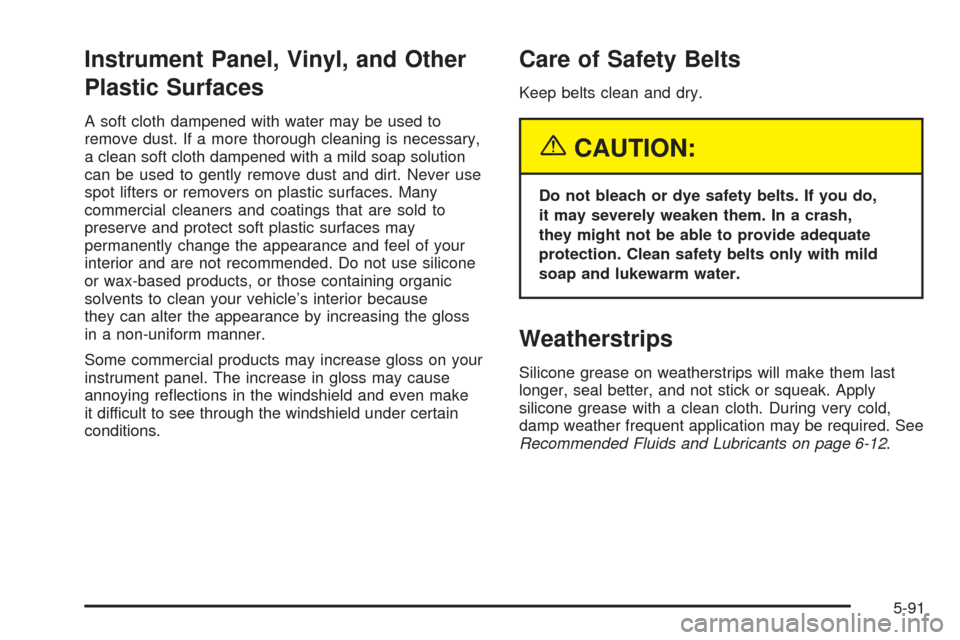
Instrument Panel, Vinyl, and Other
Plastic Surfaces
A soft cloth dampened with water may be used to
remove dust. If a more thorough cleaning is necessary,
a clean soft cloth dampened with a mild soap solution
can be used to gently remove dust and dirt. Never use
spot lifters or removers on plastic surfaces. Many
commercial cleaners and coatings that are sold to
preserve and protect soft plastic surfaces may
permanently change the appearance and feel of your
interior and are not recommended. Do not use silicone
or wax-based products, or those containing organic
solvents to clean your vehicle’s interior because
they can alter the appearance by increasing the gloss
in a non-uniform manner.
Some commercial products may increase gloss on your
instrument panel. The increase in gloss may cause
annoying re�ections in the windshield and even make
it difficult to see through the windshield under certain
conditions.
Care of Safety Belts
Keep belts clean and dry.
{CAUTION:
Do not bleach or dye safety belts. If you do,
it may severely weaken them. In a crash,
they might not be able to provide adequate
protection. Clean safety belts only with mild
soap and lukewarm water.
Weatherstrips
Silicone grease on weatherstrips will make them last
longer, seal better, and not stick or squeak. Apply
silicone grease with a clean cloth. During very cold,
damp weather frequent application may be required. See
Recommended Fluids and Lubricants on page 6-12.
5-91
Page 377 of 414
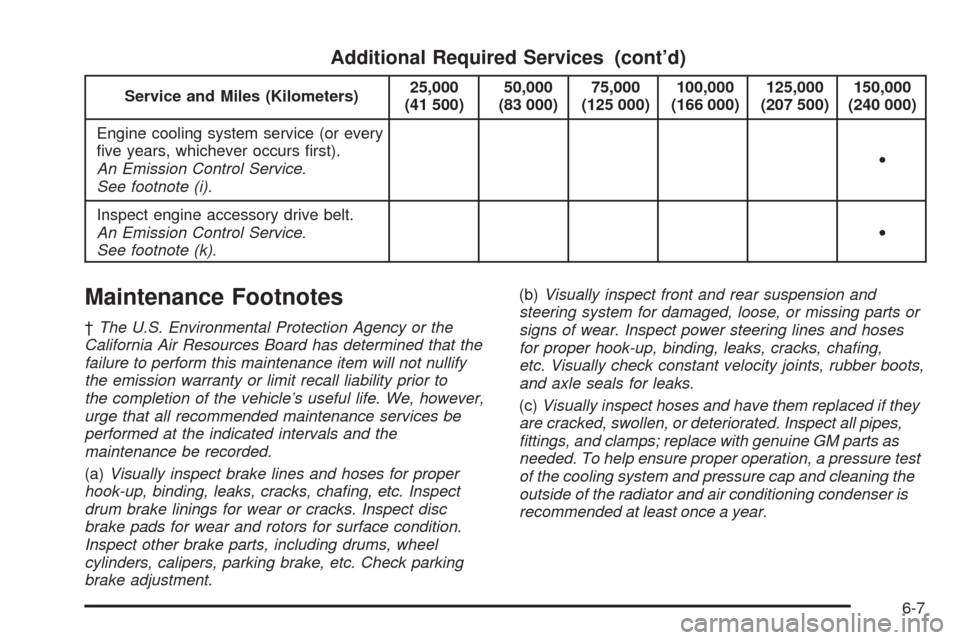
Additional Required Services (cont’d)
Service and Miles (Kilometers)25,000
(41 500)50,000
(83 000)75,000
(125 000)100,000
(166 000)125,000
(207 500)150,000
(240 000)
Engine cooling system service (or every
�ve years, whichever occurs �rst).
An Emission Control Service.
See footnote (i).•
Inspect engine accessory drive belt.
An Emission Control Service.
See footnote (k).•
Maintenance Footnotes
†The U.S. Environmental Protection Agency or the
California Air Resources Board has determined that the
failure to perform this maintenance item will not nullify
the emission warranty or limit recall liability prior to
the completion of the vehicle’s useful life. We, however,
urge that all recommended maintenance services be
performed at the indicated intervals and the
maintenance be recorded.
(a)Visually inspect brake lines and hoses for proper
hook-up, binding, leaks, cracks, cha�ng, etc. Inspect
drum brake linings for wear or cracks. Inspect disc
brake pads for wear and rotors for surface condition.
Inspect other brake parts, including drums, wheel
cylinders, calipers, parking brake, etc. Check parking
brake adjustment.(b)Visually inspect front and rear suspension and
steering system for damaged, loose, or missing parts or
signs of wear. Inspect power steering lines and hoses
for proper hook-up, binding, leaks, cracks, cha�ng,
etc. Visually check constant velocity joints, rubber boots,
and axle seals for leaks.
(c)Visually inspect hoses and have them replaced if they
are cracked, swollen, or deteriorated. Inspect all pipes,
�ttings, and clamps; replace with genuine GM parts as
needed. To help ensure proper operation, a pressure test
of the cooling system and pressure cap and cleaning the
outside of the radiator and air conditioning condenser is
recommended at least once a year.
6-7
Page 378 of 414
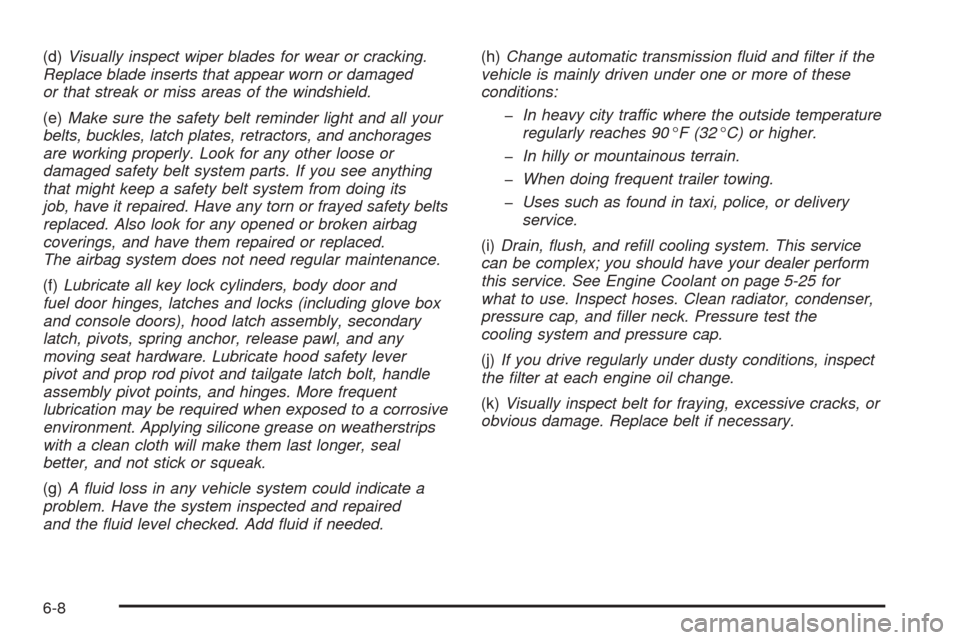
(d)Visually inspect wiper blades for wear or cracking.
Replace blade inserts that appear worn or damaged
or that streak or miss areas of the windshield.
(e)Make sure the safety belt reminder light and all your
belts, buckles, latch plates, retractors, and anchorages
are working properly. Look for any other loose or
damaged safety belt system parts. If you see anything
that might keep a safety belt system from doing its
job, have it repaired. Have any torn or frayed safety belts
replaced. Also look for any opened or broken airbag
coverings, and have them repaired or replaced.
The airbag system does not need regular maintenance.
(f)Lubricate all key lock cylinders, body door and
fuel door hinges, latches and locks (including glove box
and console doors), hood latch assembly, secondary
latch, pivots, spring anchor, release pawl, and any
moving seat hardware. Lubricate hood safety lever
pivot and prop rod pivot and tailgate latch bolt, handle
assembly pivot points, and hinges. More frequent
lubrication may be required when exposed to a corrosive
environment. Applying silicone grease on weatherstrips
with a clean cloth will make them last longer, seal
better, and not stick or squeak.
(g)A �uid loss in any vehicle system could indicate a
problem. Have the system inspected and repaired
and the �uid level checked. Add �uid if needed.(h)Change automatic transmission �uid and �lter if the
vehicle is mainly driven under one or more of these
conditions:
�In heavy city traffic where the outside temperature
regularly reaches 90°F (32°C) or higher.
�In hilly or mountainous terrain.
�When doing frequent trailer towing.
�Uses such as found in taxi, police, or delivery
service.
(i)Drain, �ush, and re�ll cooling system. This service
can be complex; you should have your dealer perform
this service. See Engine Coolant on page 5-25 for
what to use. Inspect hoses. Clean radiator, condenser,
pressure cap, and �ller neck. Pressure test the
cooling system and pressure cap.
(j)If you drive regularly under dusty conditions, inspect
the �lter at each engine oil change.
(k)Visually inspect belt for fraying, excessive cracks, or
obvious damage. Replace belt if necessary.
6-8
Page 397 of 414
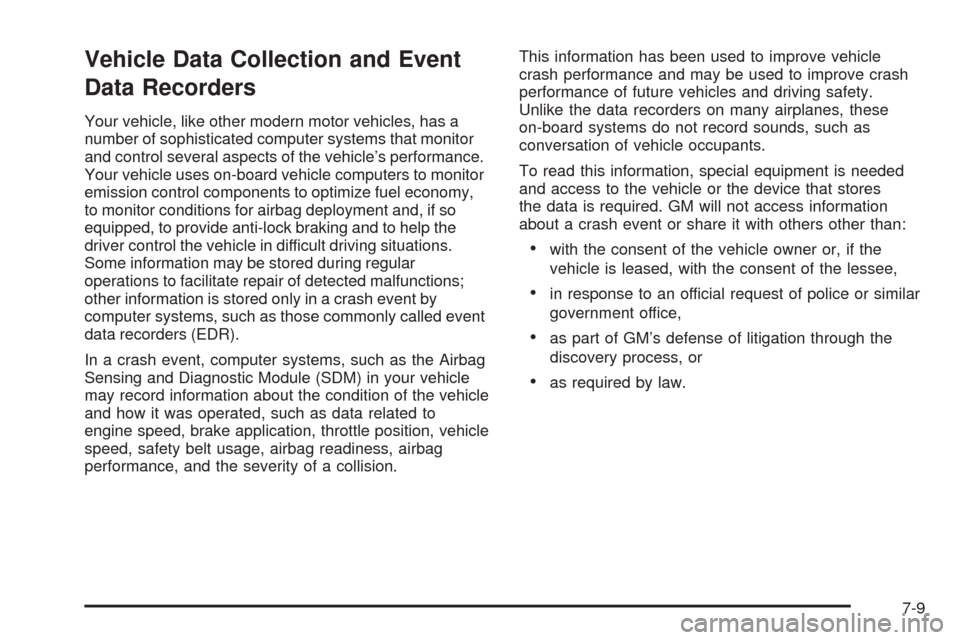
Vehicle Data Collection and Event
Data Recorders
Your vehicle, like other modern motor vehicles, has a
number of sophisticated computer systems that monitor
and control several aspects of the vehicle’s performance.
Your vehicle uses on-board vehicle computers to monitor
emission control components to optimize fuel economy,
to monitor conditions for airbag deployment and, if so
equipped, to provide anti-lock braking and to help the
driver control the vehicle in difficult driving situations.
Some information may be stored during regular
operations to facilitate repair of detected malfunctions;
other information is stored only in a crash event by
computer systems, such as those commonly called event
data recorders (EDR).
In a crash event, computer systems, such as the Airbag
Sensing and Diagnostic Module (SDM) in your vehicle
may record information about the condition of the vehicle
and how it was operated, such as data related to
engine speed, brake application, throttle position, vehicle
speed, safety belt usage, airbag readiness, airbag
performance, and the severity of a collision.This information has been used to improve vehicle
crash performance and may be used to improve crash
performance of future vehicles and driving safety.
Unlike the data recorders on many airplanes, these
on-board systems do not record sounds, such as
conversation of vehicle occupants.
To read this information, special equipment is needed
and access to the vehicle or the device that stores
the data is required. GM will not access information
about a crash event or share it with others other than:
with the consent of the vehicle owner or, if the
vehicle is leased, with the consent of the lessee,
in response to an official request of police or similar
government office,
as part of GM’s defense of litigation through the
discovery process, or
as required by law.
7-9
Page 401 of 414
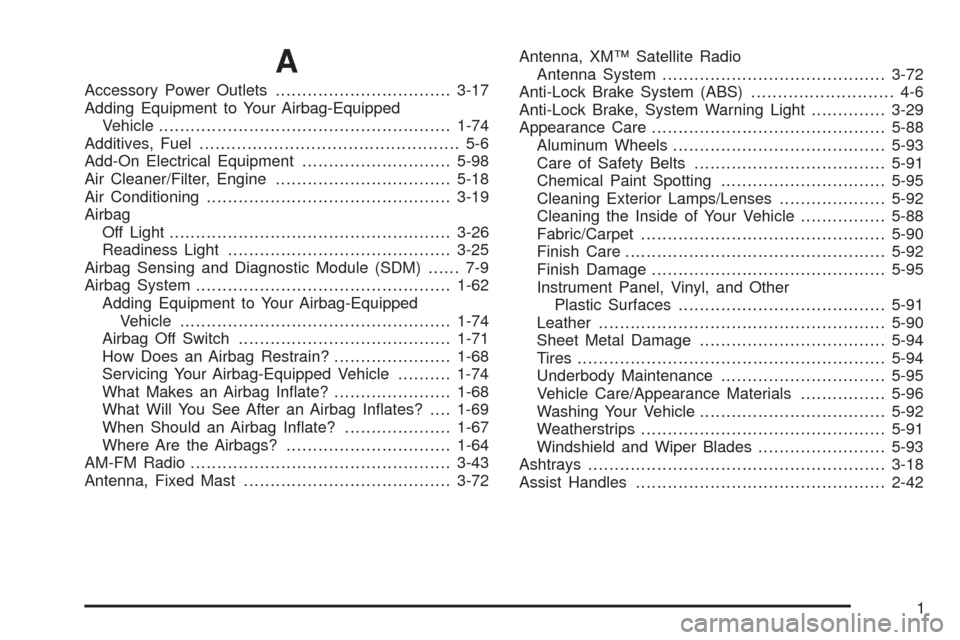
A
Accessory Power Outlets.................................3-17
Adding Equipment to Your Airbag-Equipped
Vehicle.......................................................1-74
Additives, Fuel................................................. 5-6
Add-On Electrical Equipment............................5-98
Air Cleaner/Filter, Engine.................................5-18
Air Conditioning..............................................3-19
Airbag
Off Light.....................................................3-26
Readiness Light..........................................3-25
Airbag Sensing and Diagnostic Module (SDM)...... 7-9
Airbag System................................................1-62
Adding Equipment to Your Airbag-Equipped
Vehicle...................................................1-74
Airbag Off Switch........................................1-71
How Does an Airbag Restrain?......................1-68
Servicing Your Airbag-Equipped Vehicle..........1-74
What Makes an Airbag In�ate?......................1-68
What Will You See After an Airbag In�ates?....1-69
When Should an Airbag In�ate?....................1-67
Where Are the Airbags?...............................1-64
AM-FM Radio.................................................3-43
Antenna, Fixed Mast.......................................3-72Antenna, XM™ Satellite Radio
Antenna System..........................................3-72
Anti-Lock Brake System (ABS)........................... 4-6
Anti-Lock Brake, System Warning Light..............3-29
Appearance Care............................................5-88
Aluminum Wheels........................................5-93
Care of Safety Belts....................................5-91
Chemical Paint Spotting...............................5-95
Cleaning Exterior Lamps/Lenses....................5-92
Cleaning the Inside of Your Vehicle................5-88
Fabric/Carpet..............................................5-90
Finish Care.................................................5-92
Finish Damage............................................5-95
Instrument Panel, Vinyl, and Other
Plastic Surfaces.......................................5-91
Leather......................................................5-90
Sheet Metal Damage...................................5-94
Tires..........................................................5-94
Underbody Maintenance...............................5-95
Vehicle Care/Appearance Materials................5-96
Washing Your Vehicle...................................5-92
Weatherstrips..............................................5-91
Windshield and Wiper Blades........................5-93
Ashtrays........................................................3-18
Assist Handles...............................................2-42
1
Page 403 of 414
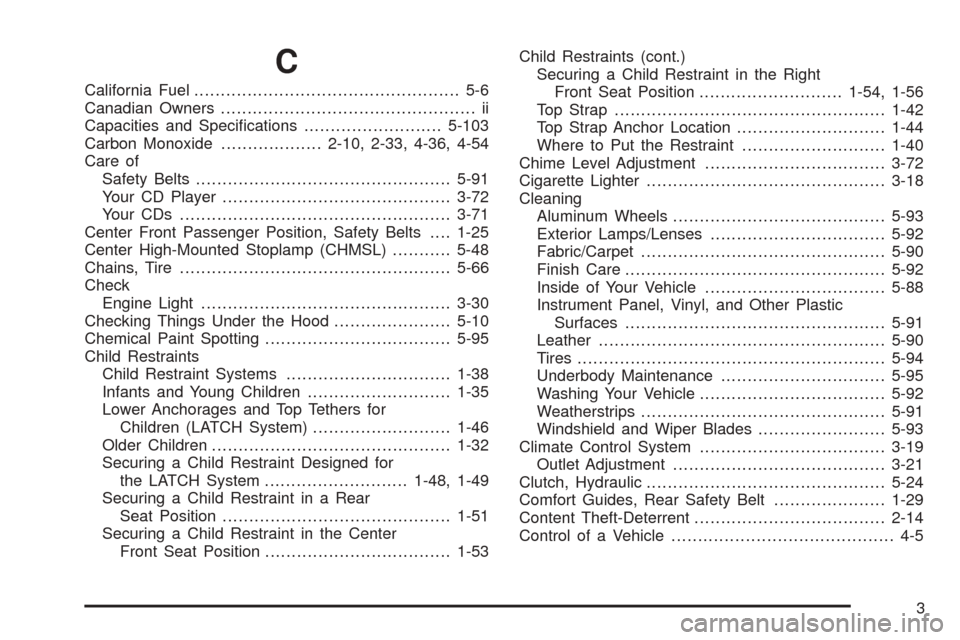
C
California Fuel.................................................. 5-6
Canadian Owners................................................ ii
Capacities and Speci�cations..........................5-103
Carbon Monoxide...................2-10, 2-33, 4-36, 4-54
Care of
Safety Belts................................................5-91
Your CD Player...........................................3-72
Your CDs ...................................................3-71
Center Front Passenger Position, Safety Belts....1-25
Center High-Mounted Stoplamp (CHMSL)...........5-48
Chains, Tire...................................................5-66
Check
Engine Light...............................................3-30
Checking Things Under the Hood......................5-10
Chemical Paint Spotting...................................5-95
Child Restraints
Child Restraint Systems...............................1-38
Infants and Young Children...........................1-35
Lower Anchorages and Top Tethers for
Children (LATCH System)..........................1-46
Older Children.............................................1-32
Securing a Child Restraint Designed for
the LATCH System...........................1-48, 1-49
Securing a Child Restraint in a Rear
Seat Position...........................................1-51
Securing a Child Restraint in the Center
Front Seat Position...................................1-53Child Restraints (cont.)
Securing a Child Restraint in the Right
Front Seat Position...........................1-54, 1-56
Top Strap...................................................1-42
Top Strap Anchor Location............................1-44
Where to Put the Restraint...........................1-40
Chime Level Adjustment..................................3-72
Cigarette Lighter.............................................3-18
Cleaning
Aluminum Wheels........................................5-93
Exterior Lamps/Lenses.................................5-92
Fabric/Carpet..............................................5-90
Finish Care.................................................5-92
Inside of Your Vehicle..................................5-88
Instrument Panel, Vinyl, and Other Plastic
Surfaces.................................................5-91
Leather......................................................5-90
Tires..........................................................5-94
Underbody Maintenance...............................5-95
Washing Your Vehicle...................................5-92
Weatherstrips..............................................5-91
Windshield and Wiper Blades........................5-93
Climate Control System...................................3-19
Outlet Adjustment........................................3-21
Clutch, Hydraulic.............................................5-24
Comfort Guides, Rear Safety Belt.....................1-29
Content Theft-Deterrent....................................2-14
Control of a Vehicle.......................................... 4-5
3
Page 404 of 414
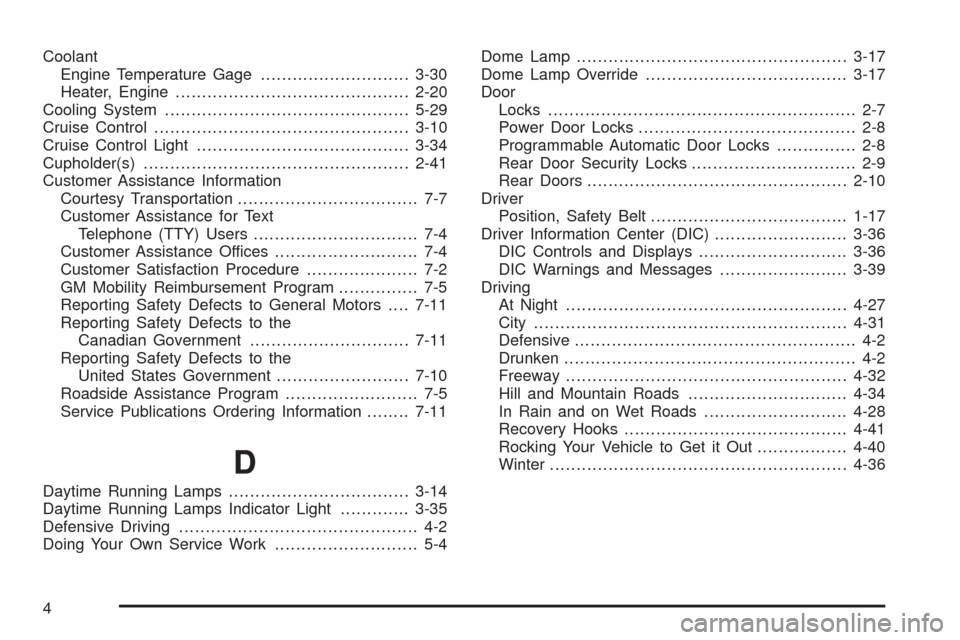
Coolant
Engine Temperature Gage............................3-30
Heater, Engine............................................2-20
Cooling System..............................................5-29
Cruise Control................................................3-10
Cruise Control Light........................................3-34
Cupholder(s)..................................................2-41
Customer Assistance Information
Courtesy Transportation.................................. 7-7
Customer Assistance for Text
Telephone (TTY) Users............................... 7-4
Customer Assistance Offices........................... 7-4
Customer Satisfaction Procedure..................... 7-2
GM Mobility Reimbursement Program............... 7-5
Reporting Safety Defects to General Motors....7-11
Reporting Safety Defects to the
Canadian Government..............................7-11
Reporting Safety Defects to the
United States Government.........................7-10
Roadside Assistance Program......................... 7-5
Service Publications Ordering Information........7-11
D
Daytime Running Lamps..................................3-14
Daytime Running Lamps Indicator Light.............3-35
Defensive Driving............................................. 4-2
Doing Your Own Service Work........................... 5-4Dome Lamp...................................................3-17
Dome Lamp Override......................................3-17
Door
Locks.......................................................... 2-7
Power Door Locks......................................... 2-8
Programmable Automatic Door Locks............... 2-8
Rear Door Security Locks............................... 2-9
Rear Doors.................................................2-10
Driver
Position, Safety Belt.....................................1-17
Driver Information Center (DIC).........................3-36
DIC Controls and Displays............................3-36
DIC Warnings and Messages........................3-39
Driving
At Night.....................................................4-27
City...........................................................4-31
Defensive..................................................... 4-2
Drunken....................................................... 4-2
Freeway.....................................................4-32
Hill and Mountain Roads..............................4-34
In Rain and on Wet Roads...........................4-28
Recovery Hooks..........................................4-41
Rocking Your Vehicle to Get it Out.................4-40
Winter........................................................4-36
4
Page 405 of 414
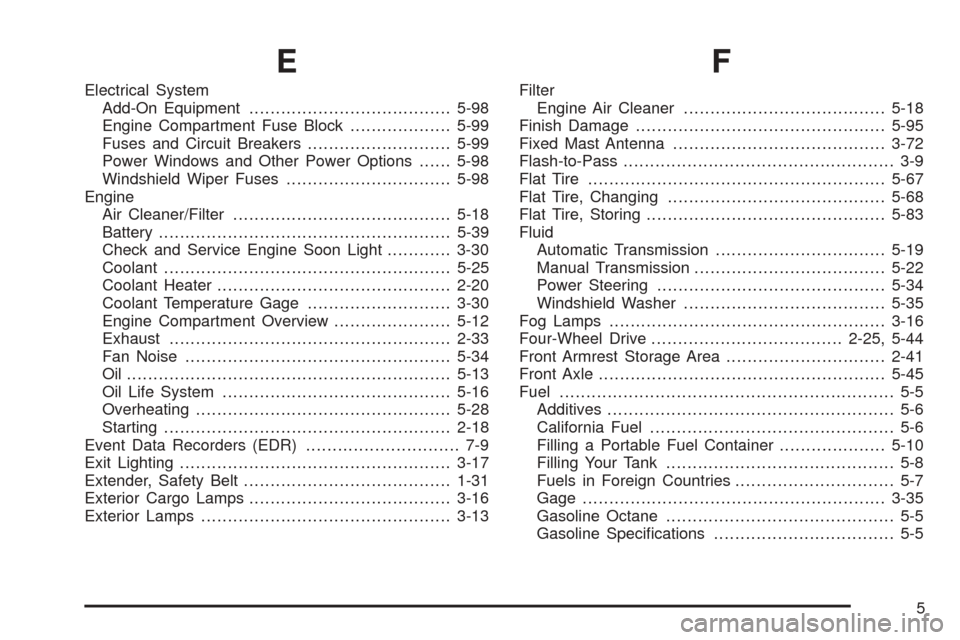
E
Electrical System
Add-On Equipment......................................5-98
Engine Compartment Fuse Block...................5-99
Fuses and Circuit Breakers...........................5-99
Power Windows and Other Power Options......5-98
Windshield Wiper Fuses...............................5-98
Engine
Air Cleaner/Filter.........................................5-18
Battery.......................................................5-39
Check and Service Engine Soon Light............3-30
Coolant......................................................5-25
Coolant Heater............................................2-20
Coolant Temperature Gage...........................3-30
Engine Compartment Overview......................5-12
Exhaust.....................................................2-33
Fan Noise..................................................5-34
Oil .............................................................5-13
Oil Life System...........................................5-16
Overheating................................................5-28
Starting......................................................2-18
Event Data Recorders (EDR)............................. 7-9
Exit Lighting...................................................3-17
Extender, Safety Belt.......................................1-31
Exterior Cargo Lamps......................................3-16
Exterior Lamps...............................................3-13
F
Filter
Engine Air Cleaner......................................5-18
Finish Damage...............................................5-95
Fixed Mast Antenna........................................3-72
Flash-to-Pass................................................... 3-9
Flat Tire........................................................5-67
Flat Tire, Changing.........................................5-68
Flat Tire, Storing.............................................5-83
Fluid
Automatic Transmission................................5-19
Manual Transmission....................................5-22
Power Steering...........................................5-34
Windshield Washer......................................5-35
Fog Lamps....................................................3-16
Four-Wheel Drive....................................2-25, 5-44
Front Armrest Storage Area..............................2-41
Front Axle......................................................5-45
Fuel............................................................... 5-5
Additives...................................................... 5-6
California Fuel.............................................. 5-6
Filling a Portable Fuel Container....................5-10
Filling Your Tank........................................... 5-8
Fuels in Foreign Countries.............................. 5-7
Gage.........................................................3-35
Gasoline Octane........................................... 5-5
Gasoline Speci�cations.................................. 5-5
5